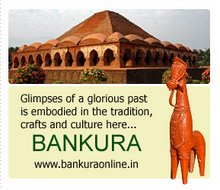Bishnupore is known and famous. The name of the district Bankura was originally Bishnupore. The administrative writ, which subsequently developed in to the district of Bankura, was known in official records as Bishnupore even in 1834 A.D., when a joint Magistrate and Deputy Collector were placed in charge of Bishnupore with head quarter at Bancoorah. Between the 16th and 17th centuries, the Gangetic Delta in Bengal, over which the Mughals had established a direct rule, was surrounded by a series of autonomous, semi-independent principalities. Mallabhum is one of the most well known among these principalities.
From a cluster of six villages, the Mallabhum grew to a large kingdom and then ultimately disintegrated. Malla dynasty ruled Bishnupur and adjacent areas for over 1000 years. But they really flourished from the 17th century.
In the seventh century A.D. King Nrisinghadeb was ruling in Pradamnapur Jotbihar in Indas PS was under Pradamnapur. But its ruler, Pratapnarayan, declared independence against the King. After failing to conquer, the King sent for Raghunatha, his loyal warrior, whom he already made a Feudal land lord to fight him. Raghunatha, who had his capital in Laugram, defeated Pratapnarayan and the King rewarded him with Jotbihar. Thus Raghunatha became a feudal king under Nrisinghadeb. After the tragic death of Nrisinghadeb, his widow married their only daughter, Chandrakumari, to Raghunatha and established him on the throne. In 695 A.D. Raghunatha was crowned as first king of Malla dynasty at Pradamnapur. To commemorate his ascending of throne a new calendar, 'Mallabda', was started in 695 A.D. or 101 Bengali calendar. King Raghunatha became known as Adi Malla and the land he ruled came to be known as 'Mallabhum'.
It was in 994 A.D. King Jagat Malla shifted his capital from Pradamnapur to Bishnupur because of better geographical safeguard as Bishnupur was surrounded by hilly terrain.
During King Veer Hambir's rule from 1565 to 1620 A.D., Bishnupur flourished. It was the 'Golden Era' of Malla dynasty. During his reign, King Veer Hambir met his future mentor, Srinivas Acharya, in a very curious incident. The meeting of the two great minds turned out to a magnificent culmination of Vaishnabism. The King with his first Queen, Shiromani and his eldest son, Dhari Hambeer, were initiated in Vaishnabism and became disciples of Srinivas Acharya. As Siddhartha became Gautam Buddha after coming in contact with dacoit Angulimala, as Chandaashok changed into Dharmaashok under the influence of Upagupta, so the bandit King, Veer Hambir, turned into an ascetic Vaishna. He became a benevolent king, who was supposed to have built that wonderful Rasmancha - a unique structure in Bishnupur, in 1600 A.D. Soon after that he built a Dalan mandir for Mrinmayee, the royal deity, in 1601 A.D. His successor Raghunath Singha built Malleshwar mandir in 1622 A.D. and dedicated the temple in the name of Veer Hambir (mentioned on the dedicatory stone slab as Veer Singha).
King Raghunath Singha built some of the most exquisite temples in Bishnupur, like Shymaraya - a pancha-ratna temple, in 1643 A.D. Keshtaraya (Jorbangla type) temple
in 1655 A.D. and Kalachand temple, an ek-ratna mandir in 1656 A.D. First two were built in brick and entirely covered with exquisite terracotta artworks. Kalachand temple was built with laterite stone, and some relics of artworks on the stone wall are still found on the temple walls. After Raghunath Singha, his son Veer Singha II built Lalji temple, an ek-ratna temple in laterite stone in 1658. Raghunath Singha I built Radhavinod aatchaalaa mandir in brick. In 1665, the Queen of Veer Singha II built two exquisite temples, Madangopala - a pancha-ratna mandir and Murulimohana, an ek-ratna laterite temple. In 1694 A.D. Durjan Singha built Madanamohana ek-ratna mandir in brick. King Gopal Singha built number of temples in Bishnupur. In 1726 three ek-ratna laterite temples came up, which are known as 'Joramandir'. Then in 1729 he built Radhagobinda ek-ratna temple in laterite stone. In 1734-35 came up Mahapravu mandir, a Jorbangla type brick temple and 1737 he built another ek-ratna
mandir in laterite, Radhamadhaba temple. In 1758 King Chaitanya Singha built Radhashyama mandir, an ek-ratna laterite temple and another similar temple in Patpur near Bishnupur. In the early nineteenth century, the Bosu family of Bishnupur built an exquisite temple, 'Sridhar mandir', the only Nava-ratna temple in Bishnupur with plenty of terracotta artworks.
Though the Malla kings shifted their capital from Pradamnapur to Bishnupur in 994 A.D., it was only from the 17th century onwards, Bishnupur started to flourish. But this great Kingdom, an independent Hindu Kingdom in the eastern India, could survive thereafter only for a little more than 150 years (1600-1758). Though during this period, they built innumerous temples in Bishnupur, we have taken into account only those temples, which are still in existence and can be visited.
Wednesday, July 18, 2007
Subscribe to:
Posts (Atom)
